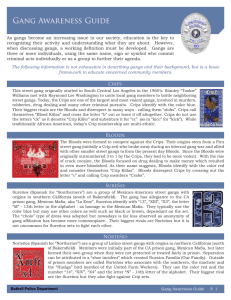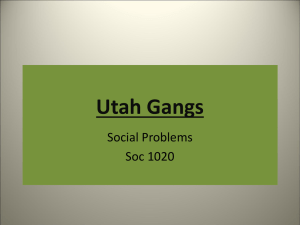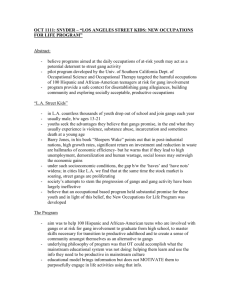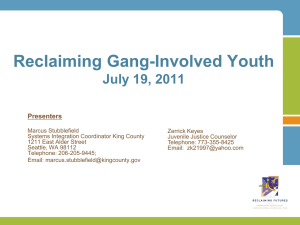Crips - Cryptome
advertisement
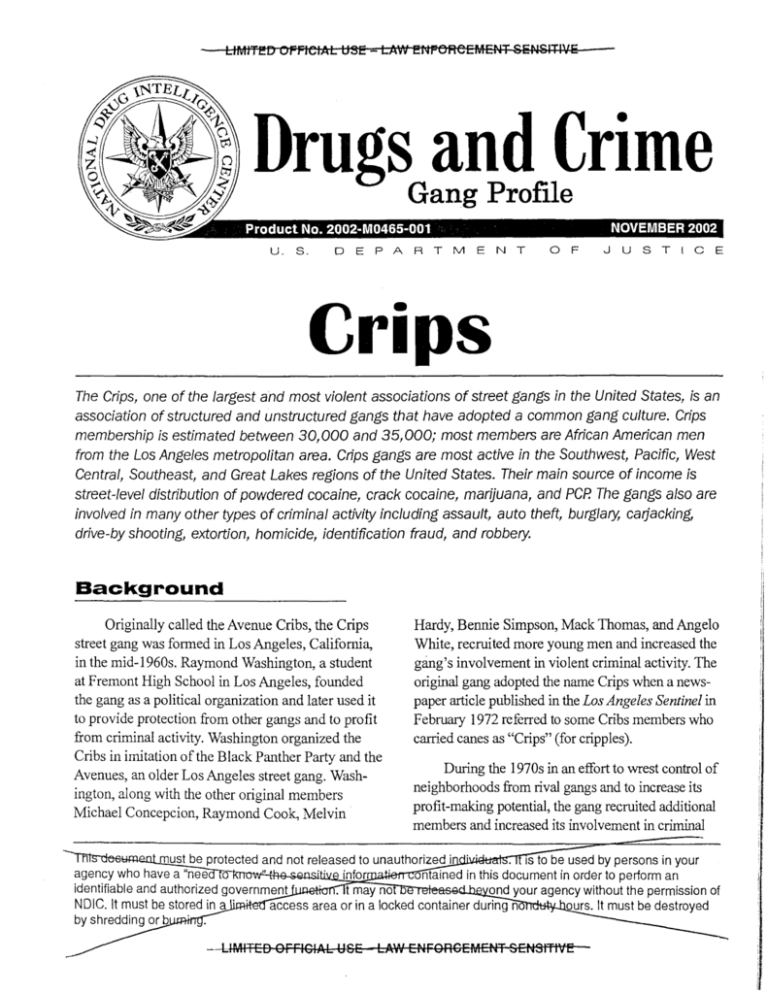
LlMIT~D
OFFICIAL USE
- LAW' ENJS'ORCCMEtJT SENSITIVI!
Drugs Gang
and
Crime
Profile
U.
S.
o
E
PAR
T
MEN
T
o
F
JUSTICE
Crips
The Crips, one of the largest and most violent associations
of street gangs in the United States, is an
association
of structured
and unstructured
gangs that have adopted a common gang culture. Crips
membership
is estimated
between 30,000 and 35,000; most members are African American men
from the Los Angeles metropolitan
area. Crips gangs are most active in the Southwest,
Pacific, West
Central, Southeast,
and Great Lakes regions of the United States. Their main source of income is
street-level
distribution
of powdered
cocaine, crack cocaine, marijuana,
and PCP. The gangs also are
involved in many other types of criminal activity including assault, auto theft, burglary, carjacking,
drive-by shooting, extortion, homicide,
identification
fraud, and robbery.
Background
Originally called the Avenue Cribs, the Crips
street gang was fonned in Los Angeles, California,
in the mid-l 960s. Raymond Washington, a student
at Fremont High School in Los Angeles, founded
the gang as a political organization and later used it
to provide protection from other gangs and to JProfit
from criminal activity. Washington organized the
Cribs in imitation of the Black Panther Party and the
Avenues, an older Los Angeles street gang. Washington, along with the other original members
Michael Concepcion, Raymond Cook, Melvin
Tfiis-de.e
must be protected
agency who have a "nee
Hardy, Bennie Simpson, Mack Thomas, and Angelo
White, recruited more young men and increased the
gang's involvement in violent criminal activity. The
original gang adopted the name Crips when a newspaper article published in the Los Angeles Sentinel in
February 1972 referred to some Cribs members who
carried canes as "Crips" (for cripples).
During the 1970s in an effort to wrest control of
neighborhoods from rival gangs and to increase its
profit-making potential, the gang recruited additional
members and increased its involvement in criminal
and not releaSE)d to unauthorized
.
" :fte sensitlll,eJnfor
i
..
.
IS to be used by persons
in your
ntained in this document in order to perform an
identifiable and authorized governmenJ.juJ:+ettorr.1t
may no
Q.
ond your agency without the permission
NOIC. It must be stored in a '~ess
area or in a locked container during n
ours. It must be destroyed
.
by shredding or b
LlMITCD
OrnCIAL -lIoE
LAW CNFOnCEMCNT
SCNSITIVE
of
Drugs and Crime Gang Profile-Crips
-
LIMITED OFFICIAL USE
activity. Initially Crips leaders did not occupy fonnal
leadership positions but were recognized as leaders
because of their personal charisma and influence.
These leaders gave priority to expanding the gang's
membership to increase its power. By 1978 there
were 45 Crips gangs, called sets, operating in Los
Angeles. Some of these Crips sets began to produce
and distribute PCP (phencyclidine) within the city.
They also began to distribute marijuana and
amphetamine in Los Angeles.
In the early 1980s Crips sets began distributing
crack cocaine in Los Angeles. The huge profits
resulting from crack cocaine distribution induced
many Crips members to establish new markets in
other cities and states. In addition, many young men
in other states adopted the Crips name and lifestyle.
As a result of these two factors, Crips membership
increased throughout the 1980s, making it one of
the largest street gang associations in the country.
In the 1990s Crips membership and involvement in drug-related activity continued to increase.
Crips sets tried to intimidate rival gangs and law
enforcement in order to control and further expand
their drug distribution enterprises. In addition,
some Crips sets reportedly attempted to deal
directly with Mexican and Colombian drug trafficking organizations to smuggle cocaine into the
United States. (It is unknown whether this activity
is continuing.) In 1999 at least 600 Crips sets with
more than 30,000 members and associate members
were identified as transporting or distributing
drugs in the United States.
The Crips remains one of the largest and most
violent associations of street gangs in Los Angeles
and the United States.
2
LNN ENfiOF'lCEMCNT SENSITIVC
Alliances
Crips belongs to the Folk Nation gang alliance. The alliance was established in the 1980s as
a means of protecting gang members incarcerated
in state and federal prison systems. The alliance is
strong within the prison system but less effective
after members are released. The Folk Nation also
includes Gangster Disciples, Black Disciples,
Black Gangsters, Imperial Gangsters, International
Posse, La Raza, Latin Disciples, Spanish Gangster
Disciples, Party People, and Satan Disciples.
Adversaries
The primary Crips rivals are the Bloods street
gangs. The Crips-Bloods rivalry began in the late
1960s when Raymond Washington and several
other Crips members confronted Silvester Scott and
Benson Owens, students at Centennial High School
in Los Angeles. Scott and Owens fought off Washington and his associates. In response to the attack,
Scott, who lived on Piru Street in nearby Compton,
established the Piru Street Gang, the first Bloods
gang, and Owens established the Westside Pims.
Other Crips adversaries include gangs belonging to the People Nation alliance, particularly the
Latin Kings. The People Nation is the rival alliance to the Folk Nation alliance and was created to
protect alliance members in the state and federal
prison systems. As with the Folk Nation, the
alliance is strong within the prison system but less
effective once a member is released. The People
Nation alliance includes the Black P Stones ,
Bloods, Cobra Stones, El Rukn, Insane Popes,
Gaylords, Future Stones, Insane Unknown, King
Cobras, Latin Counts, Latin Dragons, Latin Kings,
Latin Pachucos, Latin Saints, Spanish Lords, and
the Vice Lord Nation.
LIMITeD ut-HCIAL USE - LAW t:.Nt-OHCEMt:.NT-SENGITIVE
6~
I
bId
{
ble-
-8MITED
OFFICIAL USE - LNN ENFORCeMENT 3EN31TIVE
Organizational Structure
National
Drug Intelligence
Center
Membership
The Crips is one of the largest and most violent
street gang associations in the United States. It has
over 800 sets with 30,000 to 35,000 members and
associate members, including more than 13,000
members in Los Angeles. Over 230 law enforcement agencies representing every state except West
VIrginia and Vermont have reported the presence of
Crips in their jurisdiction. The states with the
highest estimated number of Crips sets are California, Missouri, Oklahoma, and Texas. (See map.)
Membership typically consists of African
American men in their early 30s, although members range from 10 to 40 years old. There also are
an increasing number of sets with Asian, Native
American, and Caucasian members, particularly in
the West Central, Southeast, New England, New
York/New Jersey, and Mid-Atlantic regions. All
-lJMl+ED
OrnCIAL
USE
LAv\t"ENFOF'lCEME-NT SENSITIVE
3
Drugs and Crime Gang Profile-Crips
LIMITED OFFICIAL
u::;t:
- LNN ENFOnCCMCNT
members are required to take an oath and go
through an initiation process. Initiation is achieved
in one of three ways-by committing an armed
robbery, performing a drive-by shooting, or being
beaten by members in a ceremony called a beat-in,
kangaroo walk, or bull pen. The initiation is
intended to test the prospective member's courage
and loyalty.
Members are easily identified by the symbols
and clothing they wear. They often display a sixpointed star as a symbol of the gang's association
with the Folk Nation. Other symbols used by the
gang include inverted, crossed pitchforks; words
and letters such as RSC (Rolling 60s Crips), which
identify the origin of the Crips set; and numbers
such as 118 for the 118th Street gang in Los
Angeles. Crips members also distinguish themselves by wearing clothing that is blue-the gang's
color. However, some wear colors that reflect the
name of their set. For example, the Grape Street
Crips wear purple. Crips members often wear the
apparel of professional sports teams such as the
Colorado Rockies baseball team and the Los
Angeles Lakers basketball team. They also wear
clothing to the right side of the body as a means of
showing their relationship with Folk Nation. For
example, members wear colored shoelaces (in blue
or another color associated with their set) only on
the right shoe, tilt their hats to the right, and roll up
their right pant legs.
Drug
4
Trafficking
Southwest
Region
SENSITIVC
-ttMtTED
OFFICIALUSE
Pacific
West
lA'W ENFOnCEMeNT SENSITIVE
National
Drug Intelligence
Center
Region
Central
Southeast
Region
Region
- LIMITEDOfFICIALUSE - LAW
ENFORCEMEN
I ~t:NSI"fI¥C
5
bd f bId,
67e-
Drugs
LIMITED OFFICIAL USE
and Crime Gang Profile-Crips
New
England,
New York!
New .Jersey,and Mid.
Atlantic
Regions
LAYv'[NrOnCEMENT
SENSITIVE
expand its drug distribution activities. Most violence
is targeted at rival gangs or at dealers who neglect to
pay extortion fees.
Violence between Crips sets also is common.
Most of this violence occurs due to personal
conflicts between members of different sets.
Violence also is used to ensure that members
remain faithful to the gang's culture. Crips members who have recently been released from prison
also are spurring violence between Crips sets and
.among Crips sets and rival gangs.
Outlook
Other
Criminal
Activity
Crips sets launder their drug proceeds by
investing in real estate and various cash-based
businesses including barbershops, concert promotion companies, and music stores. Crips sets also
use drug proceeds to fund recording companies and
music groups. Members engage in many other types
of criminal activity including assault, auto theft,
burglary, carjacking, drive-by shooting, extortion,
homicide, identification fraud, and robbery.
Crips sets pose a serious threat throughout the
United States. The release of gang members from
California prisons will continue to result in violence
between Crips sets and among Crips sets and rival
gangs. Additional Crips members will continue to
migrate from Southern California to pursue drug
distribution opportunities in other regions of the
country, partially because of California's "threestrikes law." For these reasons, Crips sets will increase their involvement in the transportation and
distribution of drugs in the New England, New York!
New Jersey, and Mid-Atlantic regions. The Crips will
remain one of the largest and most violent street gang
associations in the United States.
Intelligence
Gaps
Violence
Crips sets are among the most violent street
gangs in the United States. They have been responsible for numerous homicides in most major cities,
particularly Los Angeles. Crips members regularly
engage in extortion, intimidation, assault, and
homicide to further or protect their criminal activities. For example, in Jackson, Tennessee, the 107
Hoover Crips gang allegedly has committed
numerous homicides in an attempt to maintain and
6
LIMITED OFFICIAL
USE
6~,
- LAW EN~ORCeMBIT
bid
I
SEW3ITIVE
liMITeD OFFICIAL use
LAWENFORCEMeNT seNSITIVE
National Drug Intelligence Center
Sources
Federal
U.S. Department of Justice
Bureau of Prisons
Criminal Division
Organized Crime Drug Enforcement Task Force
Federal Bureau of Investigation
Office of Justice Programs
Bureau of Justice Assistance
Regional Information Sharing Systems Program
U.S. Department of the Treasury
Bureau of Alcohol, Tobacco and Firearms
State
Associated Press
National Alliance of Gang Investigators Associations
--hIMITED
OFFICIAL
U3~
LAW ENFORCEMENrsENSFHVE----
7
6.;)
.
Drugs and Grime Gang Profile-Grips
LIMITED
319 Washington
Street 5th Floor, Johnstown,
ADNET
RISSNET
-
NDIC Publications
http://ndicosa
ndic.riss.net
LIMITED
OffiCIAL
are available
OFFICIAL
USE
PA 15901-1622
LAW CNFORCEMeNT
. (814) 532-4601
on the following web sites:
LEO
home.leo.gov(!esig/ndic
INTERNET
www.usdoj.gov/ndic
use - LAW ENFORCEMENT
~CN£ITIV6
SeNCITIVE


